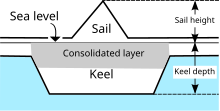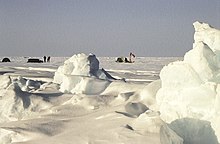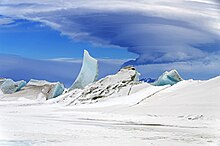
Pressure ridge (ice)

A pressure ridge, when consisting of ice, is a linear pile-up of sea ice fragments formed in pack ice by accumulation in the convergence between floes.
Such a pressure ridge develops in an ice cover as a result of a stress regime established within the plane of the ice. Within sea ice expanses, pressure ridges originate from the interaction between floes, as they collide with each other. Currents and winds are the main driving forces, but the latter are particularly effective when they have a predominant direction. Pressure ridges are made up of angular ice blocks of various sizes that pile up on the floes. The part of the ridge that is above the water surface is known as the sail; that below it as the keel. Pressure ridges are the thickest sea ice features and account for up to 30-40% of the total sea ice area and about one-half of the total sea ice volume.Stamukhi are pressure ridges that are grounded and that result from the interaction between fast ice and the drifting pack ice.
Internal structure
The blocks making up pressure ridges are mostly from the thinner ice floe involved in the interaction, but it can also include pieces from the other floe if it is not too thick. In the summer, the ridge can undergo a significant amount of weathering, which turns it into a smooth hill. During this process, the ice loses its salinity (as a result of brine drainage and meltwater flushing). This is known as an aged ridge.A fully consolidated ridge is one whose base has undergone complete freezing. The term consolidated layer is used to designate freezing up of the rubble just below the water line. The existence of a consolidated layer depends on air temperature — in this layer, the water between individual blocks is frozen, with a resulting reduction in porosity and an increase in mechanical strength. A keel's depth of an ice ridge is much higher than its sail's height - typically about 3-5 times. The keel is also 2-3 times wider than the sail. Ridges are usually melting faster than level ice, both at the surface and at the bottom. Sea-ice ridges also play an important role in confining meltwater within under-ice meltwater layers, which may lead to the formation of false bottoms.
Thickness and consolidation
One of the largest pressure ridges on record had a sail extending 12 m above the water surface, and a keel depth of 45 m. The total thickness for a multiyear ridge was reported to be 40 m. On average, total thickness ranges between 5 and 30 m and 30 m, with a mean sail height that remains below 2 m. The average keel depth of Artic ridges is 4.5 m. The sail height is usually proportional to the square root of ridge block thickness.
The average consolidated layer thickness of Artic ridges is 1.6 m. Usually, ridges are consolidating faster than level ice because of their initial macroporosity. Ridge rubble porosity (or solid ice fraction of ridge unconsolidated part) is in the wide rage of 10-40%. During winter, ice ridges are consolidating up to two times faster than level ice, with the ratio of level ice and consolidated layer thickness proportional to the square root of ridge rubble porosity. This results in 1.6-1.8 ratio of consolidated layer and level ice thickness by the end of winter season. Meanwhile, snow is usually about three times thicker above ridges than above level ice. Sometimes ridges can be found fully consolidated with the total thickness up to 8 m.
Characterization methods
The physical characterization of pressure ridges can be done using the following methods:
- Mechanical drilling of the ice with non-coring or coring augers (when the ice core is retrieved for analysis).
- Surveying, whereby a level, theodolite or a differential GPS system is used to determine sail geometry.
- Thermal drilling – drilling involving melting of the ice.
- Observation of the ice canopy by scuba divers.
- Upward looking sonars and multibeam sonars fixed on seabed or moounted on a remotely operated underwater vehicle.
- A series of thermistors (ice mass balance buoys), to monitor temperature changes.
- Electromagnetic induction, from the ice surface or from an aircraft.
Interest for pressure ridges
From an offshore engineering and naval perspective, there are three reasons why pressure ridges are a subject of investigation. Firstly, because the highest loads applied on offshore structures operating in cold oceans by drift ice are associated with these features. Secondly, when pressure ridges drift into shallower areas, their keel may come into contact with the seabed, thereby representing a risk for subsea pipelines (see Seabed gouging by ice) and other seabed installations. Thirdly, they have a significant impact on navigation. In the Arctic, ridged ice makes up about 40% of the overall mass of sea ice. First-year ridges with large macroporosity are important for the ice-associated sympagic communities and identified as potential ecological hotspots and proposed to serve as refugia of ice-associated organisms.




